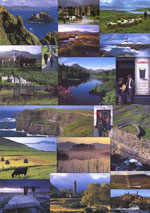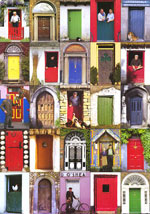| |

Traditions, folklore, history and more. If it's Irish, it's here. Or will be!
"People will not look forward to posterity who never look backward to their ancestors."
-Edmund Burke




Quotes
Library: Books, Movies, Music
Prints & Photos
Poetry
Jokes


Shops Ireland
Bunús na Gaeilge
(Basic Irish)
Circle of Prayer
Blessings
Did You Know?
Himself/Herself
Write to Us
Readers Write..
Links/Link to Us
Advertise with us
Awards & Testimonials
Submissions Guide


|
|
|
 Who Are The Irish? Who Are The Irish?
by Alicia A. Reynolds
DERRY, Northern Ireland -- Sitting at a bar in Stansted Airport sharing a pint with fellow travelers from the United Kingdom, I was asked, "How do you find the Irish?"
I wasn't sure how to answer that loaded question beyond the customary response, "They're very friendly." This, of course, is true, but the "Irish," if there truly is such a people, are much more than the stereotypical pint-drinking, fiddle-playing, joke-telling, how-are-ya, gregarious folks featured in all those travel books that fill U.S. bookstores coast to coast.
The truth is, that after being in Ireland for 10 months now, I've yet to meet any Irish people. Instead, I've met people from Donegal, County Tyrone, Dubliners, those from Cork and Limerick and, of course, the proud people of Derry.
Ireland is not so much populated by people who see themselves as Irish but as members of distinct regions and clans. What I have discovered is that the term "Irish" is really used for the sake of the foreigner, the nonindigenous outside world that can't truly begin to comprehend the subtle cultural diversity that exists within this small island.
 It's particularly amazing to me, as a Californian, to drive a mere 50 miles in any direction here in Ireland and find a noticeable difference in accents and sensibility. Donegal people aren't Derry people, and you'll not mistake a native Dubliner with someone reared in Cork. It's particularly amazing to me, as a Californian, to drive a mere 50 miles in any direction here in Ireland and find a noticeable difference in accents and sensibility. Donegal people aren't Derry people, and you'll not mistake a native Dubliner with someone reared in Cork.
However, you can literally drive for hundreds of miles throughout California, and most of the western United States, and hardly notice any change in accents or cultural norms.
But not here; people from, say, Omagh or Portstewart, both less than 50 miles from Derry, feel absolutely distinct from each other and from Derry as well. This is particularly true here in Northern Ireland where so many towns have been divided along sectarian lines. But even prior to the religious divide, Ireland was a land of clans, which have ancient roots. Indigenous people of this island have been continuous members of some of the most ancient cultures within Europe. This accounts for why people who live within a stone's throw can have such a divergent sense of identity.
This is also why a nonindigenous person living in Ireland, or even born in Ireland, can never become "Irish." Because there is no "Irish" identity in the way there is an American identity. America is based on a concept, a political ideology that can be adopted by quite literally anyone who finds his or her way to the United States.
Irish identity is based on cultural affinity to various regions and clans within Ireland. It's an intrinsic cultural identity that stems back for generations upon generations. That's why my aunt, who has lived in Ireland for 30 years and is an Irish citizen, will nonetheless never be Irish. She is an "American" who has lived, worked and raised her family in Dublin.
Similarly, city residents often tell her 42-year-old son who has lived in Dublin since the age of 4 and has raised his own family in Dublin that he's not a "real Dubliner." While many in the United States proudly think of themselves as Irish-American, my aunt doesn't have the option of calling herself American-Irish. Having a "hyphenated" sense of cultural identity is not a concept that exists here.
Ironically, the people of Ireland who were often forced to emigrate to many nations, are finding it difficult to deal with the immigrants they now find moving into their own towns and cities. TV and radio shows here in Ireland are often abuzz with the question of what to do with all the Poles, Turks, Nigerians and Chinese workers who have come to Ireland to partake of the Celtic Tiger bounty. At long last a nation that was so impoverished that millions fled its shores now is experiencing a prosperity that is attracting the world's poor in the thousands.
However unlike in America, there is no real mechanism in Ireland for assimilating people from different cultures. Strangers like myself are certainly welcome in Ireland, but no matter how long we may choose to stay, we can't ever really become Irish. It's akin to being Jewish. You can convert to Judaism but you can never really be a Jew unless you have been raised in that ancient culture. Ireland is a nation populated by native peoples who can trace their heritage back to this land for hundreds and hundreds of years. And that is essentially at the heart of the "Irish" identity -- an identity steeped in ties to land and clan. It's one thing to buy a house in Donegal, it's another thing to pass the local cemetery where great-great-grandparents are buried -- now that's what I call having a sense of identity that is tied to the very land on which you walk. Such is the reality for many who live here; they're family is quite literally rooted in the very soil of where they live.
"How do I find the 'Irish'?" Well, I suppose what I can say is that I am still looking. So far, what I have discovered is a rich tapestry of people whose deep and subtle differences are only now becoming apparent to an outsider like myself -- a welcomed stranger.
ED. NOTE: We are very grateful to the author for her kind permission to reprint this essay.
 AUTHOR'S BIO AUTHOR'S BIO
Alicia A. Reynolds, of Ventura, California, is spending a year as a Fulbright Exchange Teacher in Derry, Northern Ireland.
Images:
Irish Doors - Real Ireland print from All Posters
People and Landscapes of Ireland - Real Ireland print from All Posters
|
|
Fri, Sep 27, 2024
 The Galway Hooker The Galway Hooker
This unique vessel, with its distinctive curved lines and bright red sails, originated in the village of Claddagh. During the 19th century, hookers supported a significant fishing industry and also carried goods, livestock and fuel. Seán Rainey is remembered for building the last of the original boats, the Truelight, for Martin Oliver who was to become the last king of the Claddagh; as king, he was entitled to white sails on his boat. Since the mid seventies, many of the old sailing craft which were on the verge of extinction have been lovingly restored and new ones have been built. During the summer months they can be seen at festivals such a Cruinniú na mBád - the Gathering of the Boats - in Kinvara.
Click for More Culture Corner.
A magnificent pictorial tribute to the splendor of Irish gardens, featuring more than 200 color images.
Eclare ushers readers into spectacular Irish garden settings...
Equally captivating are the book's gorgeous photographs of plants, beautiful stonework, outstanding statuary, and the voluptuous floral compositions that adorn Ireland's great castle estates, rural herb growers, country guest houses, and quaint cottages.
Alice Joyce
Click for Glorious Gardens.
|
|
|
|
|




 The Galway Hooker
The Galway Hooker